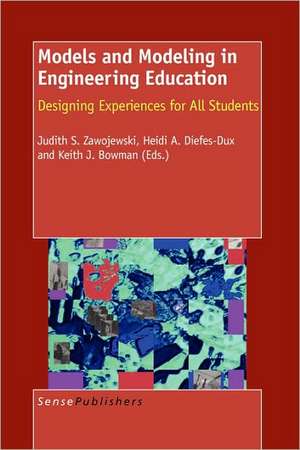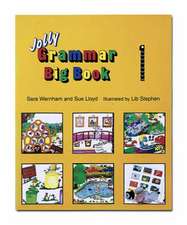Models and Modeling in Engineering Education: Designing Experiences for All Students
Judith S. Zawojewski, Heidi A. Diefes-Dux, Keith J. Bowmanen Limba Engleză Paperback – 31 dec 2007
This book is primarily being written for current and future engineering educators and researchers. The focus is on the design, development, implementation, and study of a special category of open-ended problems—the model-eliciting activity. These are realistic problems with engineering content and contexts designed to tap the strengths of all students while providing hooks to address simultaneously other educational goals. As problem solving is at the heart of engineering education and practice, it is a theme of wide appeal to engineering educators. The aims of this book are to (1) provide engineering faculty with practical tools for creating, implementing, and assessing the use of open-ended problems that meet a variety of educational goals, (2) facilitate future collaborations between engineering and education, (3) forward engineering education as a scholarly discipline by providing a resource with which to inform and teach future educators and researchers.
The book describes how incorporating mathematical modeling activities and projects, that are designed to reflect authentic engineering experience, into engineering classes has the potential to enhance and tap the diverse strengths of students who come from a variety of backgrounds. Based on the experience of a cadre of engineering and education professors who were at Purdue University during a major curriculum reform effort, this book provides a case study of the Purdue experience, which in part launched the historical beginning of the Department of Engineering Education, the first program in the United States. The reader will be provided with critical activities and tools designed during the project, and the book will be written in a way to help the reader adapt the work to their own situations.
More Detail About the Content
The NSF-funded Small Group Mathematical Modeling for Improved Gender Equity (SGMM) Project featured activities that require students to work in small technical teams to design mathematical models in response to engineering-related problems. Students produce a product for a specified client who communicates an explicitly stated need. Because the activities are designed such that the mathematical model is the answer/product, students’ mathematical thinking is revealed, providing data for formative and evaluative assessment of the curriculum innovation. The activities and the data derived from the use of the activities acted as a seeds for system reform, which resulted in changes in practice, perspectives and beliefs on the parts of engineering and education professors, and graduate researcher assistants.
The curriculum reform was initiated and studied at Purdue University between 2001 and 2005, and has involved class sizes ranging from 30 to 1400. Currently all first-year engineering students at Purdue and selected second- and third-year engineering students complete these activities in small technical teams, providing opportunities for all students to engage in authentic engineering content from day one of their educational career at Purdue. The use of meaningful problem-solving experiences, realistic engineering contexts, and small group work taps the strengths that women and minorities bring to engineering, while also providing a sound educational experience for all students that address the intent of ABET Education Criteria 2000.
Design research methodology was the theoretical frame used for studying, revising, and improving the educational innovation. The methodology is similar to design research used by research engineers, involving iterative cycles of testing and revising various aspects of the innovation. The findings indicate that students (especially women and other underrepresented groups) perceive the modeling work as interesting and motivating, and that the innovation is likely to be maintained at Purdue long beyond the life of the project. In particular, the cadre of faculty and graduate students involved in the project have learned to design the activities that adhere to a set of principles, have developed a system for gathering formative information that continues to feedback into the system for the purpose of continued improvement, have advanced in their understanding of engineering education, and many of the graduate students have moved on to university positions bringing the ideas along with them to their new environments.
The book includes three resources for the reader. The first is a theoretical framework from which to consider engineering education as moving away from “skills first, then problem solving” to “skills through problem solving with authentic engineering problems”, along with research findings that provide an empirically-based vision of this type of reform (consistent with ABET EC 2000). The second type of resource includes tools and descriptions of their use in the Purdue context. The sample tools include modeling activities, well-described implementation support systems (e. g., Internet-based assignments), and tools for gathering information (e. g., survey items, interview protocol) that can be readily adapted to the reader’s own programmatic situation. As a third resource, the reference list includes readings that span engineering education to educational research that will be useful as others pursue reading and research in the multi-disciplinary field of engineering education.
Preț: 414.31 lei
Nou
Puncte Express: 621
Preț estimativ în valută:
79.29€ • 82.47$ • 65.46£
79.29€ • 82.47$ • 65.46£
Carte tipărită la comandă
Livrare economică 11-17 aprilie
Preluare comenzi: 021 569.72.76
Specificații
ISBN-13: 9789087904029
ISBN-10: 9087904029
Pagini: 364
Dimensiuni: 155 x 235 x 19 mm
Greutate: 0.41 kg
Editura: Brill
Colecția Brill
Locul publicării:Netherlands
ISBN-10: 9087904029
Pagini: 364
Dimensiuni: 155 x 235 x 19 mm
Greutate: 0.41 kg
Editura: Brill
Colecția Brill
Locul publicării:Netherlands










